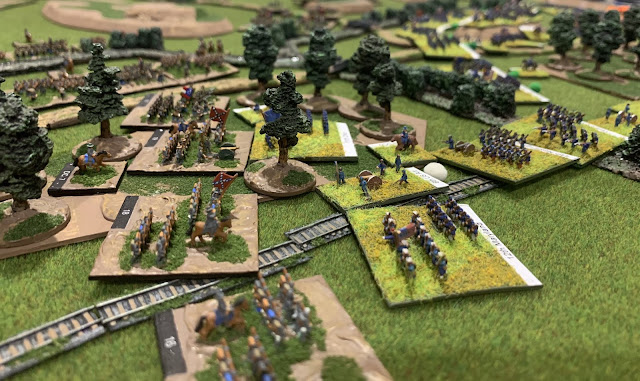This week’s game was another fictional encounter this time set in the American Civil War during 1862. As is often the case it was another multiplayer engagement.
With Richmond secure General Lee determined to strike north and take the battle to Washington. Having defeated Pope at Second Bull Run Lee once again faced McClellan.
Lee’s army was far from concentrated. Initially what was available was drawn from Longstreet’s Wing. In all Old Pete had at his disposal just three divisions around Burkittsville. Jackson in contrast had just one division on the field with two more due to arrive in three hours. Fortunately General Stuart was on hand with one cavalry division.
McClellan was likewise dispersed and true to character determined to deploy his army along the meandering banks of Folly Run and its tributaries. The stream was heavy with trees in many areas reducing visibility. However along the Run Little Mac felt comfortable he could halt, what was in his mind at least, the numerically superior Rebel army.
Lee ordered the Longstreet to demonstrate along Folly Run massing his artillery at selected points to gain numerical advantage over the Union guns or more importantly engage the Union infantry. One such was the concentration on Longstreet’s right where 24 corps artillery pieces were gathered in an area less constrained by trees in an attempt to break up the Union line. Below, Longstreet’s main artillery concentration, comprising smoothbore and rifled artillery.
Lee’s army was far from concentrated. Initially what was available was drawn from Longstreet’s Wing. In all Old Pete had at his disposal just three divisions around Burkittsville. Jackson in contrast had just one division on the field with two more due to arrive in three hours. Fortunately General Stuart was on hand with one cavalry division.
McClellan was likewise dispersed and true to character determined to deploy his army along the meandering banks of Folly Run and its tributaries. The stream was heavy with trees in many areas reducing visibility. However along the Run Little Mac felt comfortable he could halt, what was in his mind at least, the numerically superior Rebel army.
Lee ordered the Longstreet to demonstrate along Folly Run massing his artillery at selected points to gain numerical advantage over the Union guns or more importantly engage the Union infantry. One such was the concentration on Longstreet’s right where 24 corps artillery pieces were gathered in an area less constrained by trees in an attempt to break up the Union line. Below, Longstreet’s main artillery concentration, comprising smoothbore and rifled artillery.
Lee however was less clear on where Jackson should deploy, except he should extend Longstreet’s right. Sensing an opportunity Stonewall pressed the Union left. Leading the advance was A.P Hills Light Division, which comprised four brigades, the others being detached. These brigades quickly crossed the west tributary of Folly Run. No sooner had the division crossed it began to press an advanced Union division, that of Brigadier General Abner Doubleday’s, drawn from Hooker’s I Corps, before it could fully deploy.
Below, the general situation with the Confederates on the left and visible crossing one of the tributaries of Folly Run. Union forces are pushing across the run, having crossed via a railroad bridge on an unfinished branch line. This area was to be a significant point of fighting.
Doubleday’s division was soon heavily engaged in the woods and near the unfinished branch of the Baltimore and Ohio railroad. With Lee now in the area, and concerned by reports from Longstreet that he was suffering heavy losses to his artillery, Lee dispatched staff officers to Jackson recommending caution. Yet Jackson was fired up. He ordered Hill to press the Yankees with vigour. His gamble paid dividends and soon Doubleday’s division was streaming back across the east tributary of Folly Run.
Below, Doubleday’s division are engaged along the unfinished branch line.
Yet, Jackson was not done. Forming a battery of 24 guns he hoped to discomfort the next division of Hooker’s Corps. In support several infantry brigades drawn from Ewell’s and Hill’s divisions moved forward and began an exchange of fire with the Yankees lining the banks of the east tributary.
However, Jackson now turned to his reserve, Taliaferro’s Division, he hoped his old division would apply the next to point of pressure.
Taliaferro was ordered across Folly Run near the confluence of the east and west branches. Starke’s brigade was first across around 8pm and now spurred on by General Lee himself the brigade poured fire on to Hooker’s flank. McClellan formed a hasty counterattack and supported by artillery intended to through the Rebel attackers back. Instead it was the Union infantry who were thrown back and McClellan wounded.
As darkness closed in so to the Rebel attack faltered. After eight hours of engagement McClellan’s line had held. The Confederates had suffered marginally heavier casualties, especially in artillery - a result of intense Union counter battery fire. Likewise, Jackson’s three divisions had suffered heavy casualties, in particular Ewell’s division. Yet Hooker’s Corps was weakening after sustained casualties and the collapse of Doubleday’s Division was problematic. There could however, be no denying McClellan’s victory.
The scenario was of course fictional and developed with the Road to Glory scenario system. The armies comprised 3000 points and the game involved four players. Miniatures are from Heroics & Ros with the Confederates from my own collection and the Union from Jon’s collection.
The scenario was of course fictional and developed with the Road to Glory scenario system. The armies comprised 3000 points and the game involved four players. Miniatures are from Heroics & Ros with the Confederates from my own collection and the Union from Jon’s collection.






Comments
Post a Comment